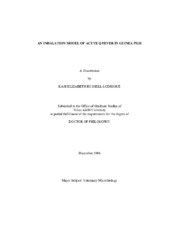| dc.description.abstract | Coxiella burnetii is an intracellular pathogen that can cause both acute and
chronic disease (Q fever) in humans and infects many animals with varying clinical
illness and persistence. A guinea pig aerosol-challenge model of acute Q fever was
developed using infection with C. burnetii across a 5-log range of challenge doses.
Clinical signs included fever, weight loss, respiratory difficulty, and death, with degree
and duration of response corresponding to dose of organism delivered. Histopathologic
evaluation revealed coalescing panleukocytic bronchointerstitial pneumonia 7 days after
a high-dose challenge, resolving to multifocal lymphohistiocytic interstitial pneumonia
by 28 days. Clinical and pathologic changes noted in these guinea pigs were comparable
to those seen in human acute Q fever, making this an accurate and valuable animal
model. This model was used to compare the relative virulence of eight isolates from four
different genotypic groups: I (RSA493, RSA334, and RSA270), IV (Q177 and Q173), V
(Q212 and Q217), and VI (5J108-111). Guinea pigs infected with group I acute-diseaseassociated
isolates had severe respiratory disease, while no to moderate clinical illness
was observed in animals given group IV or V chronic-disease-associated isolates. 5J108-
111 appeared avirulent. These data suggest that C. burnetii isolates have a range of
disease potentials and support a distinction in strain virulence between established genotypic groups, though isolates within the same genomic group cause similar
pathologic responses. Heterologous protection was confirmed by cross vaccination and
challenge with RSA493 and Q217. A marked non-specific suppression of
lymphoproliferation was noted at 14 and 28 days post infection with RSA493; similar
suppression was seen after infection with Q173 and Q212 but not 5J108-111. Proinflammatory
cytokines IFN-γ and TNF-α were produced during early C. burnetii
infection, at which time anti-inflammatory cytokines TGF-β and IL-10 were repressed.
A vaccine made from phase I C. burnetii was found to be completely protective against
lethal infection in the guinea pig model, while vaccination with killed phase II organisms
conferred only partial protection, preventing death and reducing but not precluding fever
and respiratory illness. Protective vaccination significantly stimulated cell-mediated
immunity and elicited increases in IFN-γ, TNF-α, and IL-12p40 mRNA levels. | en |


